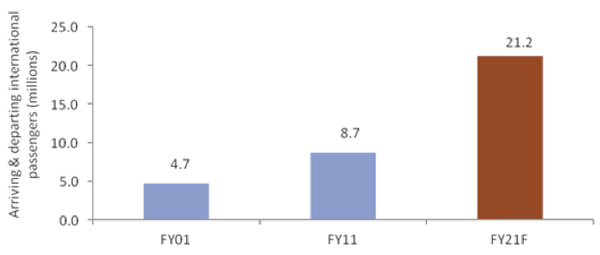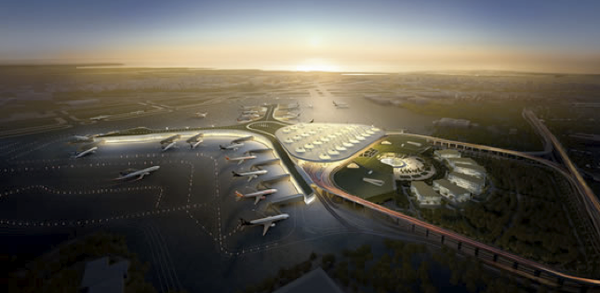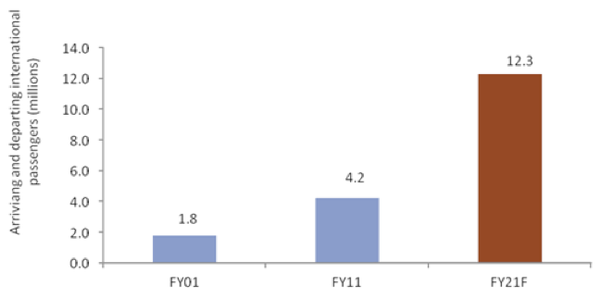Indian airport retail tenders herald the next wave of travel retail growth
With both Mumbai and Chennai airports releasing tenders in Aug-2012 for duty free and retail concessions at their new terminals, the Indian travel retail scene is set for yet another boost, following on from the impact of the opening of Delhi which has raced ahead to become the largest duty free market in the country.
Although non-aeronautical revenue at major Indian airports is growing and considerable progress in this arena has been made in recent years, it still lags in the global context. The global duty free market was around USD23 billion in 2010, while duty free sales in India amounted to only around USD215 million in FY2011 (with growth of around 25-30% forecast for FY2012), which is less than 1% of the total revenue, while Indian airports handle around 3% of global airport passenger traffic. Compare this to Dubai, which reported sales of USD1.46 billion from duty free in 2011. All Chinese airports registered combined revenue of USD1.9 billion.
See related article: CAPA Report: Potential for USD3.5bn of duty free, retail, F&B spend at Indian airports
Overall, non-aeronautical revenues accounted for 46.5% of airports' income worldwide in 2010 at around USD47 billion, according to the most recent Airport Economics Survey released by Airports Council International (ACI) in Jan-2012, underlying the key role that commercial and non-aviation revenues increasingly play in driving airport revenues. ACI World director general Angela Gittens said at the time: "Non-aeronautical revenues are a vital component in the economics of airports. During the downturn the diversification of airport revenues cushioned the impact of lower passenger and freight volumes and safeguarded operating profits. Non-aeronautical revenues critically determine the financial viability of an airport as they tend to generate higher profit margins than aeronautical activities, the latter frequently representing a zero sum game or producing a deficit."
In 2011, the Asia Pacific region outperformed Europe in duty free and travel retail sales for the first time with sales of USD16 billion, up 25.5% on 2010 levels, according to Generation Research. Of the USD46 billion worth of global duty free and travel retail sales, 35% was generated in the Asia Pacific region, 34% in Europe, 23% in the Americas, 7% in the Middle East and 1% in Africa.
Mumbai Airport duty free revenue estimated to grow from USD60m in FY2011 to USD384m by FY2021
Mumbai will open its new integrated Terminal 2 to domestic passengers in 2013 and international passengers in 2014, and will have a total passenger capacity of 40 million. However, runway constraints may make traffic growth challenging above 37 million without increasing load factors and the average size of aircraft. With traffic already at 30 million the airport is fast approaching saturation. A second airport is proposed at Navi Mumbai to serve the Mumbai Metropolitan Region. Construction of this facility is yet to commence which suggests that it is unlikely to open prior to 2017/18, leaving the city of Mumbai with a potential capacity crunch in the interim.
Mumbai International Airport Pvt Ltd (MIAL) is conducting a series for competitive bids for the award of non-exclusive rights for retail and other commercial services at T2. These include duty free, advertising, speciality retail and food and beverage as well as today's categories. As part of this, MIAL on 28-Aug-2012 launched an RFQ for a term of five years to design, develop, set up, operate, maintain and manage the entire T2 Destination Retail area measuring about 559sqm (bids are due on 14-Sep-2012). It also launched an RFP for the T2 Lounge Concession to develop and operate common use lounges for CIP (commercially important persons) passengers (bids due on 11-Sep-2012). This RFQ has an 11-year tenancy term for managing approximately 6000sqm of CIP lounge space.
In its India Travel Retail Report 2012, CAPA forecasts that duty free turnover in the Mumbai Metropolitan Region (MMR) - across both airports - could grow from USD60 million in FY2011 to USD384 million in FY2021, a 10-year compound annual growth rate of 20.3%. Alcohol sales are expected to remain the largest category, worth USD154 million. Other retail and food and beverage could total a further USD398 million. The pace of transformation is dramatic when you consider that as recently as five years ago duty free sales at Mumbai were less than USD10 million.
International arriving and departing passengers handled at Mumbai International Airport: FY2001, FY2011 and CAPA forecast for FY2021
The CAPA India Travel Retail Report interviewed more than 7000 passengers across 12 Indian airports with some of the key qualitative findings for Mumbai as follows:
- As arguably India's most cosmopolitan city, with the highest density of people in households with incomes over USD100,000, Mumbai has huge potential as a retail market, with a large number of sophisticated, well travelled passengers;
- Female travellers expressed a desire to see more international brand cosmetics, fashion, sunglasses and shoes at the airport. Male travellers stated that they would like to see a greater range of cigars, electronics, and watches. These were categories with strong interest which were assessed as being poorly represented in the current retail offer;
- Passengers were also keen to see affordable Indian brands alongside regular international brands while foreign travellers were interested in destination products such as handicrafts, herbal products, and ethnic jewellery;
- Domestic passengers were happy with the ambience of the new upper concourse but felt that the pricing of food and beverage was very high or that more affordable options were inconveniently located;
- The categories of retail product now available at the new section of the domestic terminal are seen as being of high quality but not felt to be commonly purchased products. Travellers suggested that there should be more everyday brands available as well as more utilitarian stores such as a chemist;
- Passengers would like to see additional facilities such as a play zone for kids, affordable spa, nap and shower etc;
- The ability to purchase duty paid liquor on arrival at the domestic terminal is seen as a very positive development;
- Lounges are very crowded and during peak hours and it can be more comfortable to wait in the public areas of the airport.
Artist renderings of Mumbai International Airport Terminal 2
Chennai Airport duty free revenue estimated at around USD15m in FY2011, USD188m by FY2021
Chennai Airport's duty free revenue is estimated at around USD15 million in FY2011. The Airports Authority of India (AAI) has placed limited attention on developing non-aeronautical revenue streams, hence the average duty free spend per international passenger stood at USD3.50 across AAI airports in FY2011, compared with USD6.70 at Mumbai. If leveraged appropriately, CAPA estimates that from this low base Chennai could achieve even faster growth than Mumbai, to reach duty free sales of USD188 million by FY2021. However, this is recognised as being optimistic and is subject to the AAI adopting a more commercial approach to its operations. Continuation of the status quo on this front will result in a lower forecast.
The new Chennai Airport will have nearly three times the current retail space. Retail space at the existing domestic and international terminals is 3250sqm, comprising 60 concessions including duty-free, retail shops, restaurants and snack bars and executive lounges. The retail space earmarked in the new terminals is around 9000sqm. Infrastructure Development Corporation has been appointed as the consultant to advise on enhancing non-aeronautical sources of revenue at the new terminals, including food and beverage and retail. The expansion of the Chennai Airport, which includes construction of a new domestic terminal and expansion of the international terminal, has been long in the making, with the deadline being revised several times.
International arriving and departing passengers handled at Chennai Airport: FY2001 and FY2011 and CAPA forecast for FY2021
The CAPA India Travel Retail Report revealed the following qualitative findings for Chennai Airport:
- In the case of Chennai the passenger view was not unsurprisingly that the retail offer at Chennai is very basic, with limited shopping and food and beverage options. Prices were not considered to be competitive. Local residents are quite excited to see how this is going to improve with the opening of the new terminal. At present passengers indicated that they prefer to shop while in transit at another airport due to the lack of products offered in Chennai;
- Those aged under 40 expressed strong interest in electronic goods, both on departure and arrival;
- Passengers of all ages were keen to see a large, high quality bookstore at the airport, also offering international CDs and DVDs;
- Male travellers were interested in electronics, pens and watches, aside from the regular duty free staples of alcohol and tobacco;
- Female travellers would like to see cosmetics, jewellery and diamonds;
- Aside from fast food and sandwiches, there is a strong preference for South Indian eateries.
With a range of important concessions up for grabs at Mumbai and Chennai airports, Indian airports are beginning to follow their global counterparts in altering their revenue models to reflect the opportunities created by the retail sector. Unsurprisingly, it is the nation's larger and modernising airports such as Mumbai, Delhi, Bengaluru, Hyderabad, and Chennai which are driving this change, although with continued upgradation programmes across the country, a focus on retail development is expected to increase. Non-aeronautical revenue, which at some airports is on-par with or even greater than aeronautical revenue particularly is a key component in enabling airports to generate funds for the significant investment they must undertake in terminal and airfield expansion. The commercial revenue stream is essential for positive credit ratings and the airport's ability to attract investors, an important factor as airport operations are increasingly outsourced to private operators.


